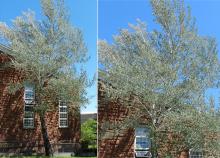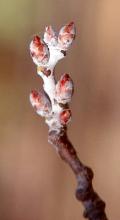Populus alba
Common name:
White Poplar
European White Poplar
Silver Poplar
Pronunciation:
pop-U-lus AL-ba
Family:
Salicaceae
Genus:
Type:
Broadleaf
Native to (or naturalized in) Oregon:
No
- Deciduous, large tree, 40-70 ft (12-21 m) tall with a similar spread. Bud and twigs covered with short white hairs. Bark is initially smooth and whitish gray, becoming rough and dark with age. Leaves alternate, simple, on long shoots 3-5 lobes, coarsely toothed, 5-13 cm long, dark green above, silvery gray and densely woolly underneath, on short branches smaller, only 2.5-5 cm, oval to elliptic-oblong. Male and female trees (dioecious), small flowers in catkins, male catkins 5-7 cm long, female catkins 7-10 cm long. Fruit catkins are made up of small, green pods that splits open when ripe and spread cottony seeds by wind.
- Sun. Easy to grow. Does best in moist, deep loam. Messy and has brittle branches.
- Hardy to USDA Zone 3 Native to Europe, western Siberia, and central Asia. One of the first trees introduced from Europe to North America, where it has since hybridized with several native Populus species. Listed as an invasive species in some states.
- alba: Latin, whitish, a reference to the color of the underside of the leaves.









